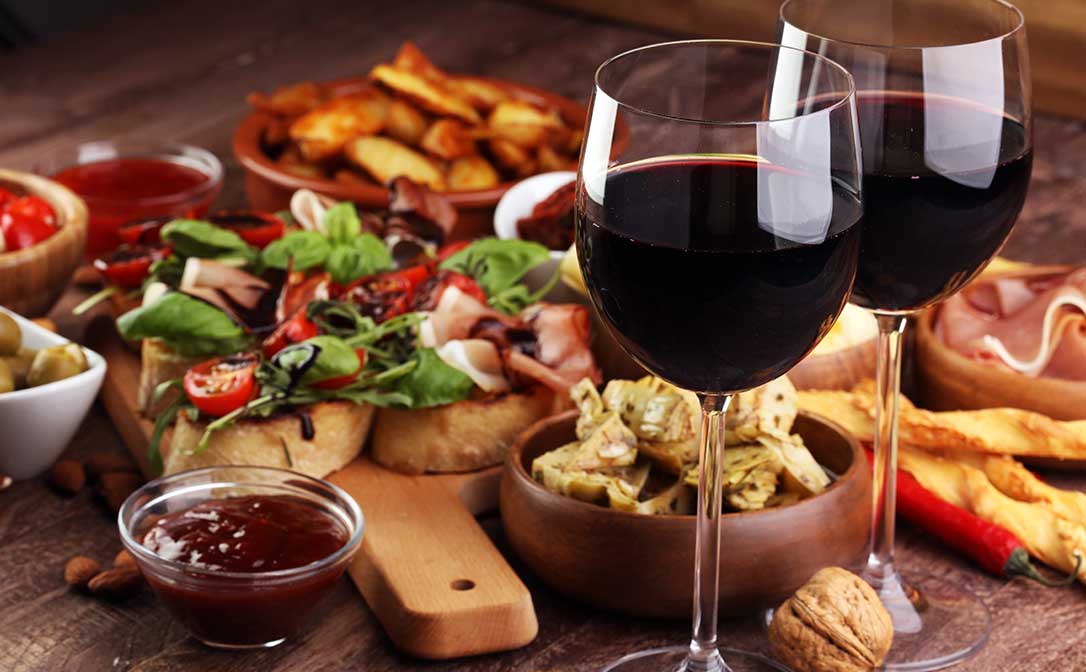Basic ‘how to’ on pairing Food and Wine
One of the biggest challenges in planning a meal, not to mention a series of gatherings with family and friends, is that the wine is in perfect harmony with the menu of choice, taking into account all personal likes and dislikes.
This guide on wine and food pairing will ensure you avoid disasters and make everyone happy and satisfied. These core principles allow you to be creative, find your own combinations, and challenge any assumptions or misleading rules.
Basic elements in food and wine
The first important point to consider is the various variables and factors that shape the tasting experience of wine and food jointly.
In wine, you’ll have to consider:
Acidity
Sweetness
Bitterness
Tannins
Alcohol
During a meal, these will be interacting with the food’s:
Fat
Saltiness
Sweetness
Spiciness
Acidity
Sourness

The fundamental principles of wine & food pairing
Pairing is essentially the act of balancing the conflicting forces between wine and food that complement or cancel each other out. Here are some basic rules to keep in mind.
Wine should have higher acidity than the food
Foods which are high in acid affect the perception of acidity in the wine you drink. So low acidity wines feel very flat when paired with acidic dishes.
Sweetness asks for sweetness (but not always)
Like acidity, the sweetness of food reduces the perception of the sweetness of wine. Therefore, sweet wines help to taste the flavour of sweet recipes by emphasizing the complexity beyond the sugar content. However, sweet dishes are effective when combined with refreshing dry wines to balance their richness. And sweet wines can also be in perfect harmony with openly savoury foods.
Food and wine should have the same intensity
However, intensity can be balanced in different ways. It can be about balancing the flavour intensity of the food with the tannin structure of the wine. Alternatively, balance the fat content of the dish with high-acidity wine. Make sure you don’t use overtly powerful wines in very delicate and subdued recipes.
Fat requires structure – not just tannins or alcohol
Powerful reds are commonly mistaken to only pair up with fat dripping meats or rich cheeses. In fact, a powerful red will only make the fat even more prominent on the palate and more difficult to enjoy and digest. On the other hand, a glass of refreshing, rich sparkling wine (such as aged champagne) brings out the flavour complexity and richness of fatty dishes. So don’t just look at bold, overly tannic red wines, consider acidity driven complex wines (traditional sparkling, orange wines) or more sour red wines like Nebbiolo and Sangioveses can all make for better pairings.
Think of the sauce, not the meat
A common mistake is, for example, pairing chicken with the same wine, regardless of how it’s cooked. In fact, herb-fried chicken requires a completely different companion than chicken in mustard sauce. It is far more important to consider the taste and texture of the spices and sauces used to flavour it than the base protein itself.
Spiciness, a game of trial and error
Spices vary greatly in strength and properties. It’s not enough to classify a dish as “spicy” to determine the best wine to accompany it. Some spices are spicier, others sweeter, and each reacts differently when used in a particular recipe. Instead of following rules, finding a wine for a spicy dish is often a matter of trial and error and each pairing a specific exercise.
Find contrasting or matching pairings
You can play around with the pairings by following one of two different approaches: you can find contrasting matches or corresponding matches:
– In matching pair, the food and wine will have similar levels of the same component (for example a creamy, buttery rich white wine with a creamy pasta dish)
– Complementary pairings balance conflicting ingredients on the same level (e.g. richness of high-fat recipes balanced with high-acid wines).
Remember, back yourself
The science behind these core principles should simply give you the freedom to play, experiment, and discover your own tastes. Tasting is a highly subjective experience, so at the end of the day you can decide which wines to pair with your favourite dishes. Where there is comfort food, there is always comfort wine.
Source: wanderlustwine.co.uk